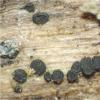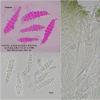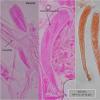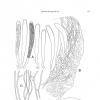
31-08-2013 00:22
 Rubén Martínez-Gil
Rubén Martínez-Gil
Hola a todos.Subo unas fotos de una Peziza que enc

30-08-2013 23:17
Esquivel-Rios EduardoHola Todos.Esta Scutellinia encontrada en el tronc

27-08-2013 23:27
Marcus YeoBonjourI found this discomycete recently growing
Apothecia discoid, black, growing on wood of Quercus.
Size up 800um diameter.
Spores hyaline with 9-11 transverse septa and 1-2 longitudinal septa.
IKI (-). Asci containing many conidia?
Paraphyses filiform, septate, divided. (x 1-1.5um).
I think it may be next to Patellaria, but I have no information.
Any ideas.
Thanks in advance.
Susana (Spain)
Encaja perfectamente.
Un saludo
Susana

I fully agree with Martin's ID. Did you collect on Quercus robur/petraea or was it a submediterranean or mediterranean site?
Zotto
The sample is collected in Sarasibar (Navarra).
The oak that grows in this area is Quercus petraea.
The climate is submediterranean? or Subatlantic? I leave a link if you have interest.
http://meteo.navarra.es/definiciones/koppen.cfm
A greeting.
Susana






